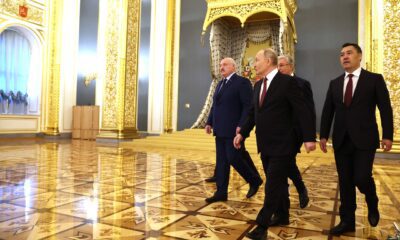Global Issues
Eurasian Economic Union (EAEU): Opportunities, Challenges and Future Pathways -By Kestér Kenn Klomegâh
In accordance with the Treaty on the EAEU, the chairmanship of the Supreme Council, the Intergovernmental Council and the Commission Council is carried out on a rotational basis in the order of the Russian alphabet by one member state for one calendar year without the right of extension. The Eurasian Economic Union includes Russia, Armenia, Belarus, Kazakhstan, Kyrgyzstan, Russia and Uzbekistan.

A series of meetings have been held to review performance and discuss crucial challenges almost half way into Russia’s chairmanship of the Commonwealth of Independent States (CIS) in 2024, and five of these former Soviet republics are also members of the Eurasian Economic Union (EAEU). After Soviet’s collapse in 1991, Russia has had a chequered history of bilateral relations with the sovereign republics. From 1st January this year, Armenia, with sharp varied incoherent and political differences in relations to Russia, has currently assumed the presidency of the Eurasian Union whose membership includes five independent sovereign republics.
“As of January 1, 2024, the Republic of Armenia assumed the presidency of the bodies of the Eurasian Economic Union, and presides over the Supreme Eurasian Economic Council, the Eurasian Intergovernmental Council and the Council of the Eurasian Economic Commission,” the EEC press service reported at the beginning of January 2024.
In accordance with the Treaty on the EAEU, the chairmanship of the Supreme Council, the Intergovernmental Council and the Commission Council is carried out on a rotational basis in the order of the Russian alphabet by one member state for one calendar year without the right of extension. The Eurasian Economic Union includes Russia, Armenia, Belarus, Kazakhstan, Kyrgyzstan, Russia and Uzbekistan.
As stipulated by the guidelines, Armenia’s chairmanship witnesses a meeting of the Supreme Eurasian Economic Council in Moscow dedicated to the tenth anniversary of the Eurasian Economic Union. The Third Eurasian Economic Forum, a meeting of the Eurasian Intergovernmental Council, and a number of other events are planned throughout the 2024.
During the first week of May 2024, Vladimir Putin took part in the meeting of the Supreme Eurasian Economic Council, timed to coincide with the tenth anniversary of the signing of the Treaty on the Eurasian Economic Union. Records show that taking part in the restricted format meeting were leaders of the Eurasian Economic Union member countries: President of Belarus Alexander Lukashenko, President of Kazakhstan Kassym-Jomart Tokayev, President of Kyrgyzstan Sadyr Japarov, Prime Minister of Armenia Nikol Pashinyan, and Chairman of the Board of the Eurasian Economic Commission Bakytzhan Sagintayev.
The heads of the observer states – President of Cuba Miguel Diaz-Canel Bermudez and President of Uzbekistan Shavkat Mirziyoyev – as well as CIS General Secretary Sergei Lebedev joined the work of the Supreme Eurasian Economic Council during its expanded format meeting. A package of reviewed documents was signed following the meeting, in particular, the protocols concerning business and trade among member states.
Aside the general meeting, Putin had one-to-one meeting at the Kremlin with Prime Minister of Armenia Nikol Pashinyan, and emphasized that Armenia has seen a very substantial increase in its trade with EAEU countries since 2015. “As for bilateral relations, we have been successful in expanding them. Economic cooperation has invariably been the primary focus. Last year, we saw a substantial increase in trade, largely due to higher imports, or exports, if we look at it from Armenia’s perspective. Trade exceeded $7 billion. We have never seen such high levels in our trade and economic relations before,” Putin underscored in remarks during the meeting.
According to Putin, bilateral relations must go beyond trade. There are regional security matters on agenda too. Putin discussed behind closed doors, possibly all aspects, including regional security matters, within the context of current situation with Ukraine, and also between Armenia-Azerbaijan conflict where Russia recently withdrew its peace-keeping force.
Republic of Uzbekistan Shavkat Mirziyoyev noted with Putin the bilateral relations dynamics, trade hitting the mark of $5 billion. He raised other important issues, something beneficial for both and for the region. Mirziyoyev called for further systematizing the process of establishing partner relations between the EAEU.
The Eurasian Economic Union (EAEU) considers broader cooperation with the Shanghai Cooperation Organization (SCO) as a crucial avenue of its activities, Eurasian Economic Commission Board Chairman Bakytzhan Sagintayev said.
“Broader cooperation with the SCO is a key avenue for us. The EAEU and the SCO have set up an institutional basis for interaction, signed a memorandum, and are finalizing a plan of events for 2024-2025 towards implementing the memorandum, and its regulating bodies have arranged a systemic dialogue,” Belarus’s BelTA state news agency quoted Sagintayev as saying while opening a CIS international economic forum in Moscow.
The EAEU is interacting with SCO countries not so much in a dialogue format as primarily in the form of trade agreements, Sagintayev said. “For instance, the EAEU and its member states have concluded a trade and economic cooperation agreement with China. A free trade agreement has been signed with Iran,” Sagintayev said.
“The development of a systemic dialogue with the SCO, ASEAN, BRICS countries, and other countries and associations concerned in the context of greater Eurasian partnership is among the priorities of the union’s international affairs as stipulated in its principal strategic high-level documents,” he said, and added that the EAEU is consistently building infrastructure for a dialogue with key players in the Greater Eurasian area.
There are a number of recent achievements, for instance, the industrial output in the Eurasian Economic Union (EAEU) countries rose 4.7% year-on-year in January, with all EAEU countries demonstrating growth, according to the EAEU press service. “The EAEU had an industrial production volume of 104.7% in January 2024, on par with January 2023,” the press service indicated in its report.
Armenia had growth in industrial output of 21%, Kyrgyzstan of 16.5%, Belarus of 5.4%, Russia of 4.6%, and Kazakhstan of 3.4%, the Eurasian Economic Commission (EEC) said. The EEC said that the volume of output increased by 0.7% in mining and quarrying; by 7.5% in manufacturing; by 4.9% in electricity, gas, steam, and air conditioning; and by 3.3% in water, sewerage, and waste collection and distribution.
There was an assessment of other spheres including agriculture. The Eurasian Economic Union’s agricultural output fell 1.1% in 2023. Regarding individual countries within the union, there was growth in Belarus – 1.1% and Kyrgyzstan – 0.6%, but drops in Kazakhstan – 7.7% and Russia – 0.3%.
“In 2023, across all categories of farms in the EAEU, preliminary data indicates a gross grain harvest of 169.4 million tonnes, down 11.1% from the previous year, 30 million tonnes of potatoes, up 5.4% and 22.9 million tonnes of vegetables, down 0.4%,” the EEC said.
“In the same period, the production of key livestock products increased within the EAEU: livestock and poultry in live weight rose by 2.2% compared to 2022, milk increased by 3%, and egg production grew by 0.8%,” the report says. In all EAEU member states, except Armenia, saw increases in the production of livestock and poultry in live weight and milk. Egg production rose in Kyrgyzstan and Russia but decreased in Armenia, Kazakhstan, and Belarus.
It is noteworthy to describe Russia and Belarus relationship as indivisible, even though both are members of the EAEU they formed the Russian-Belarus Union. This is a supranational union with the stated aim of deepening the relationship exclusively between the two states through integration in economic and defence policy. As of 2024, the current president of the Supreme State Council of the Union is Alexander Lukashenko, who has held the position since 2000. Putin and Lukashenko meets frequently, especially now when both are cooperating in the ‘special military operation’ in Ukraine. Furthermore, the military doctrine of the Russian Federation provides that “an armed attack on the state-participant in the Union State, as well as all other actions involving the use of military force against it,” should be deemed “an act of aggression against the Union State”, authorizing Moscow to “take measures in response” accordingly. This is also to remind that these couple of years, Russia and Belarus have come under stringent sanctions of the United States and Europe.
Across the region, there are distinctive underlying causes which are well-known and therefore allowing its possible effects to largely influence the already-stressed economic development processes could produce unprecedented outcomes. Therefore, the leaders consider seriously deepening the economic integration with a view to creating a common economic space, but significant noticeable success is hindered by gamut of problems. On the other side, Russia wants to dominate and impose its position on the republics, it is pursuing ‘special military operation’ in Ukraine which has some implications for the republics in the region. It has disparaging attitudes towards the United States and Europe, which the republics have their own interpretations.
In the context of the current geopolitical changes, Russia thinks positively the idea for expanding cultural and humanitarian interaction. Compared to European Union, the Eurasian Union which is largely part of the CIS lacks some fundamental contractual and legal foundation such single currency, free movement of goods and people, and a unified required document (EU passport) for travelling in the region. In addition, Russia wants its language and culture to be the most generally accepted by all the participating republics.
That however, the five EAEU members have unreservedly expressed support for new initiatives in order to have continuous positive economic trends despite the existing challenges and political roadblocks. In fact, parallel participation by EAEU countries and their partners within the CIS in the Shanghai Cooperation Organization and BRICS could also open up doors to huge benefits among them.
The Economic Development Strategy of the CIS for the period up to 2030 adopted by a resolution of the CIS Heads of Government on May 29, 2020, and other CIS fundamental programme documents. For Russia, it is necessary to create conditions for ensuring the continuity of its activities and reaching a number of multifaceted goals. In the first place, Russia preference is based on promoting cooperation in the military area and on border security. The the EAEU member states are Armenia, Belarus, Kazakhstan, Kyrgyzstan, Russia and Uzbekistan. These are also members of the Commonwealth of Independent States (CIS) formed after collapse of the powerful Soviet Union.


















